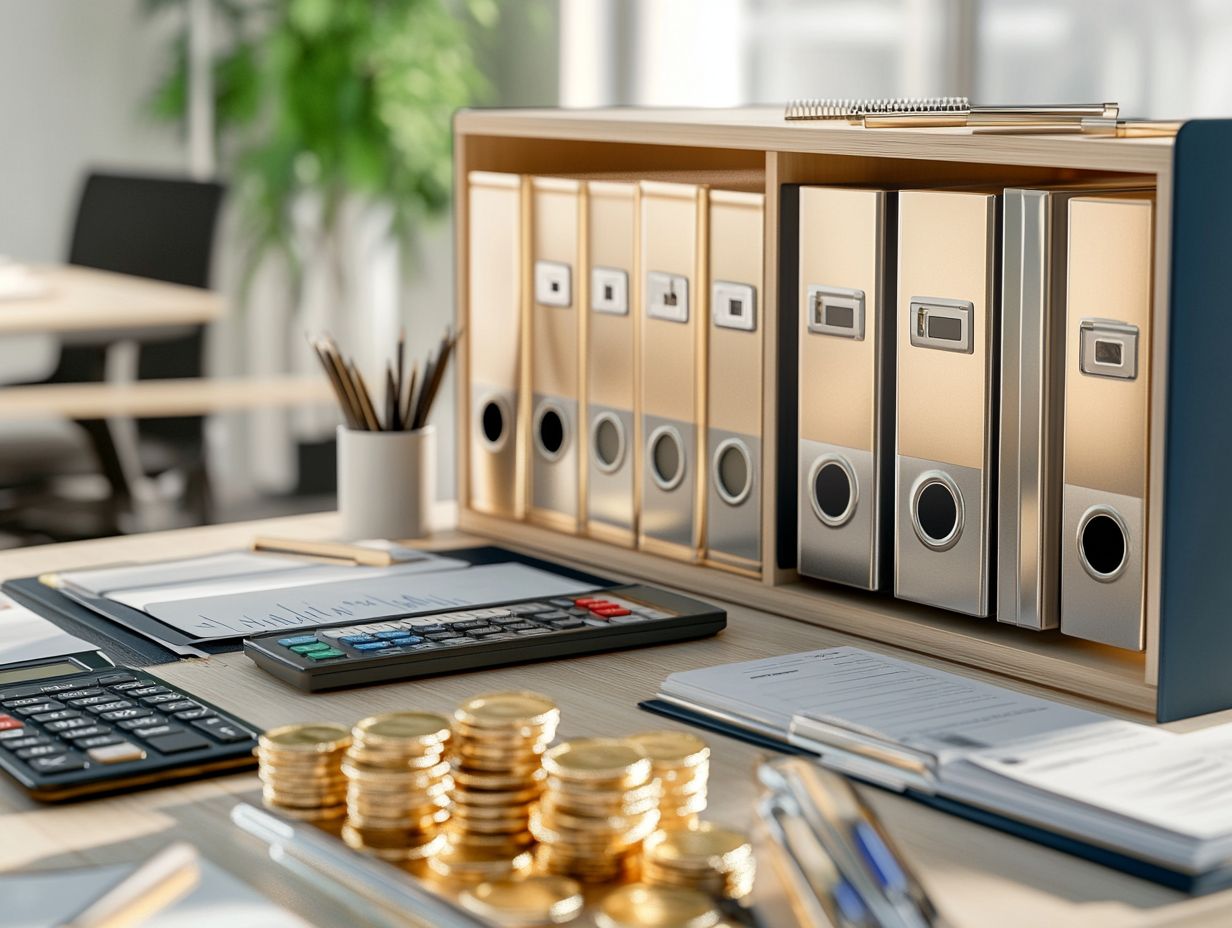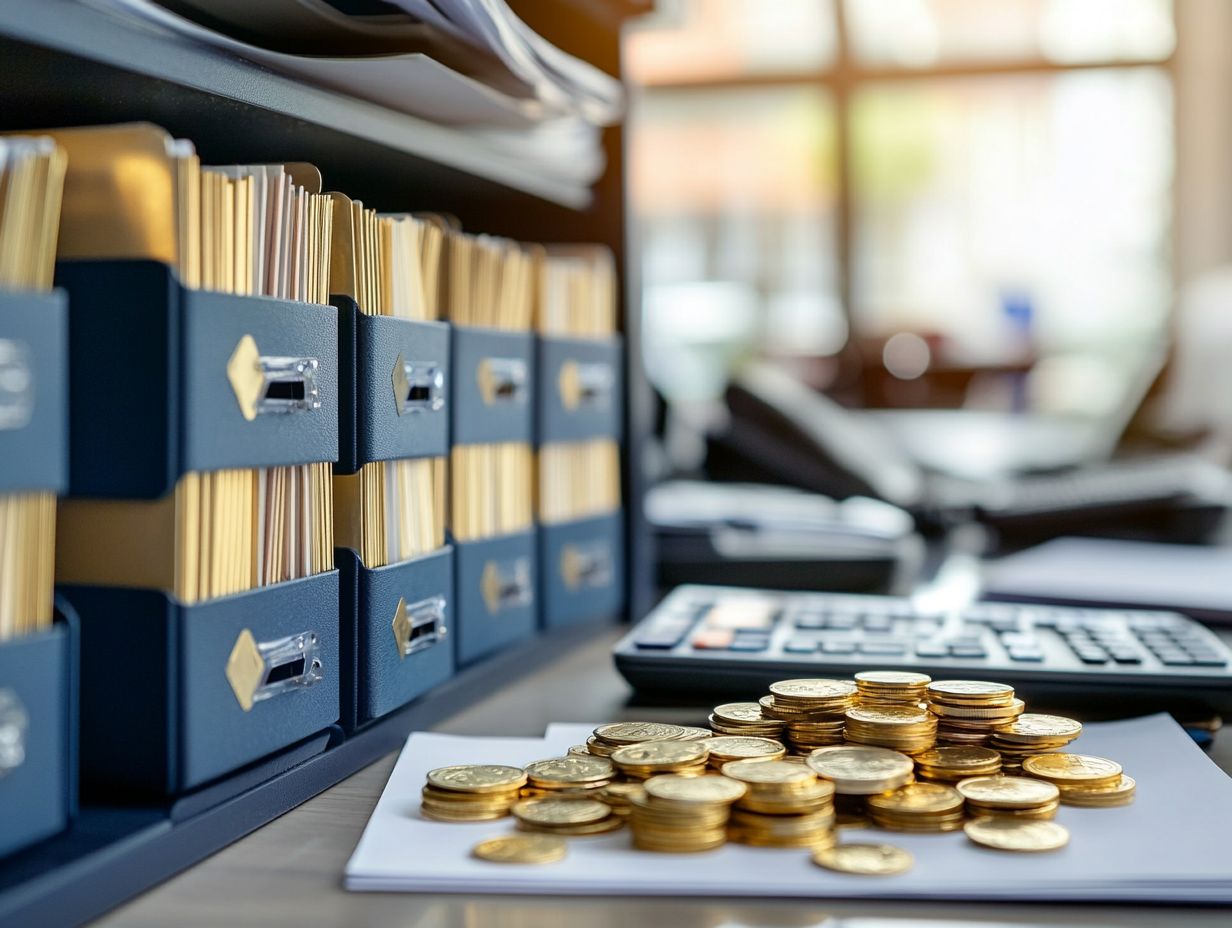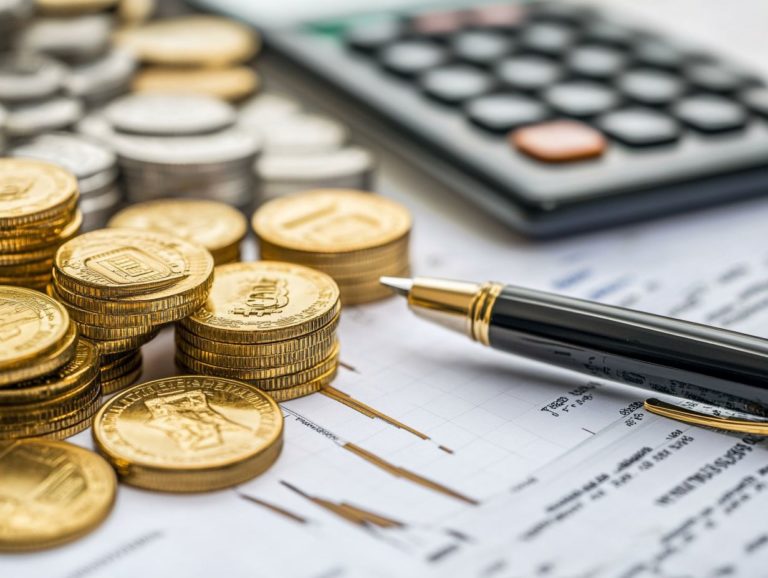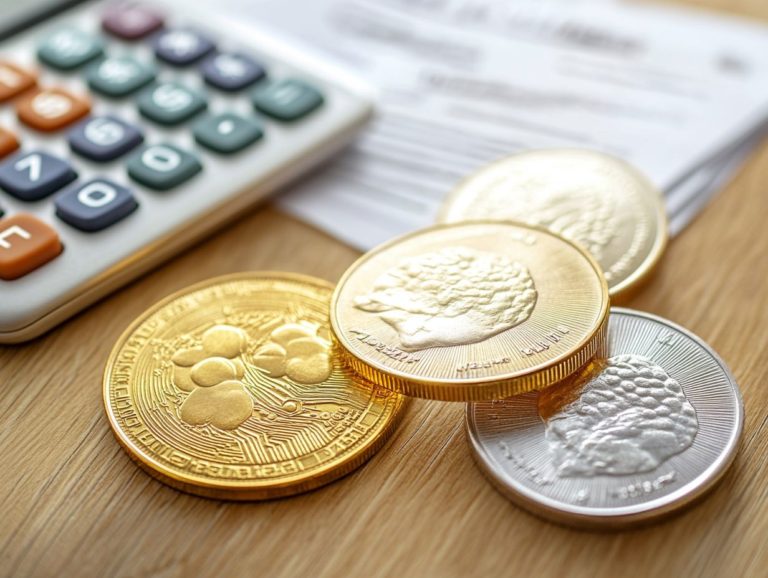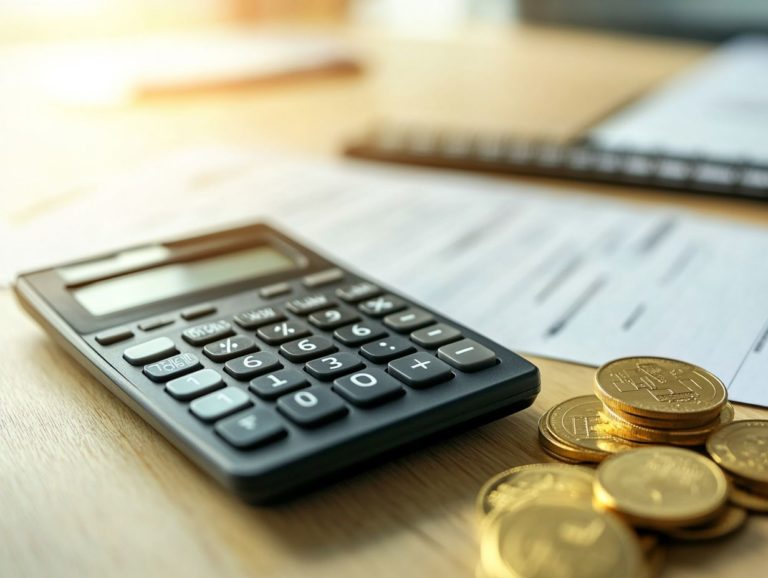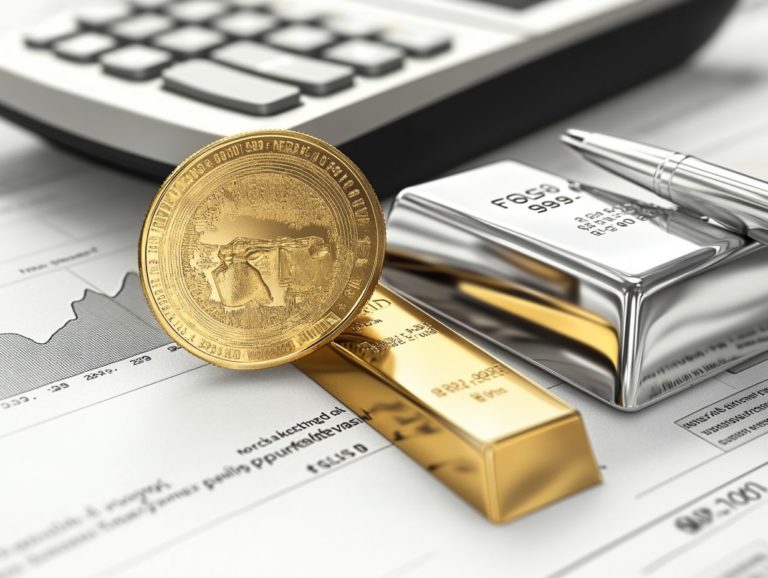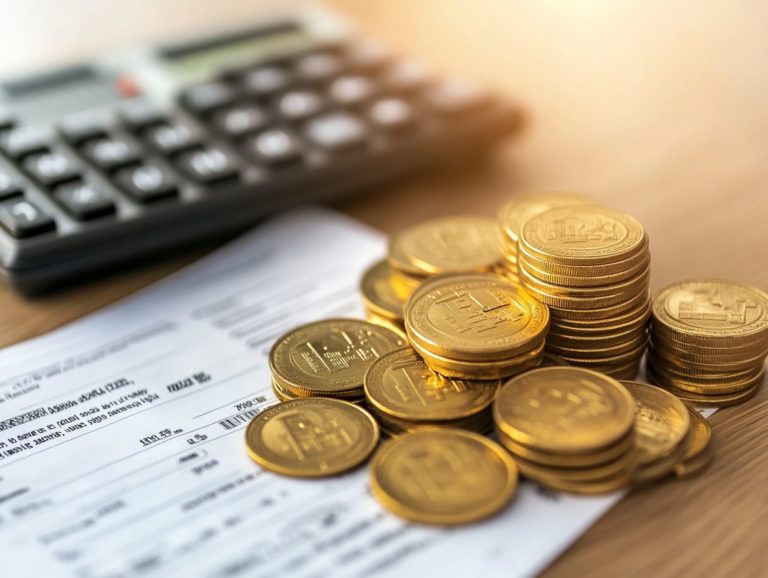What Tax Records to Keep for Precious Metals Investments
Investing in precious metals can be a highly rewarding venture. However, grasping the tax implications is essential for safeguarding your profits.
This guide will walk you through the intricacies of taxation on precious metals. We’ll emphasize the records you need to maintain for precise reporting.
You’ll also find information on the necessary IRS forms and deadlines, ensuring compliance.
Explore effective tax strategies designed to maximize your gains. You’ll also discover insights on leveraging tax-advantaged accounts.
Start now to protect and grow your financial future!
Contents
- Key Takeaways:
- Understanding Tax Implications of Precious Metals Investments
- Records to Keep for Precious Metals Investments
- Tax Forms and Reporting Requirements
- Tax Strategies for Maximizing Profits
- Frequently Asked Questions
- What tax records do I need to keep for my precious metals investments?
- Do I need to report my precious metals investments on my taxes?
- How long should I keep my tax records for my precious metals investments?
- What information should I include in my tax records for my precious metals investments?
- Can I deduct losses from my precious metals investments on my taxes?
- Do I need to keep records of my inherited precious metals investments?
Key Takeaways:
- Keep accurate records of all precious metals investments to ensure proper tax reporting.
- Familiarize yourself with IRS forms and reporting requirements for gains on precious metals investments.
- Utilize tax strategies like tax-advantaged accounts to minimize taxes on precious metals investments and maximize profits.
Understanding Tax Implications of Precious Metals Investments
Understanding the tax implications of investing in precious metals, such as physical gold and silver, is essential for you as a U.S. investor. You want to maximize returns during times of economic uncertainty. The tax requirements can vary greatly depending on the type of precious metals you choose and the investment strategies you employ.
Having a solid grasp of IRS regulations is vital for effective tax planning.
Overview of Taxation on Precious Metals
The taxation of precious metals, like physical gold and silver, presents unique considerations. This includes a special tax on collectibles that can influence your investment profits and capital gains.
You should be aware that the IRS classifies precious metals as collectibles. Selling these assets might subject you to potentially higher tax rates compared to standard capital gains. Specifically, collectibles are taxed at a maximum rate of 28%, whereas the typical long-term capital gains rate can be significantly lower, depending on your tax bracket.
This distinction carries critical implications for you as an investor in the U.S. To avoid penalties, it’s crucial to report your investment income and losses accurately on the appropriate IRS forms, such as Schedule D.
Having a grasp of these tax nuances can be pivotal in maximizing the overall returns on your precious metal investments.
Records to Keep for Precious Metals Investments
Maintaining precise records for your precious metals investments, including gold and silver coins, is essential for effective tax reporting. Keeping good records helps you follow the rules and can save you money!
This diligence ensures compliance with IRS regulations, allowing you to accurately determine your cost basis (the original value of your investments) and avoid unnecessary storage fees.
By keeping everything organized, you’ll simplify your tax season and optimize your investment management.
Types of Records to Keep
To ensure you meet tax reporting requirements, it’s essential to maintain a comprehensive set of records for your precious metals investments. This includes everything from purchase invoices and sales receipts to thorough documentation of your gold and silver holdings.
Along with these crucial documents, keeping a detailed inventory that tracks the quantity, quality, and cost basis of your gold and silver can significantly streamline your tax return preparation. Knowing precisely when and how much you’ve bought or sold is vital, as it directly impacts your capital gains calculations.
The IRS mandates that you report your gains and losses on Schedule D, making the accurate input of this information essential for effective tax planning.
By establishing a systematic approach to record-keeping, you simplify your reporting process and enable yourself to make informed investment decisions. This proactive strategy can ultimately pave the way for increased financial success.
Importance of Accurate Record Keeping
Accurate record keeping is crucial for understanding the tax implications of your precious metals investments. It provides a transparent view of your investment documentation, highlighting both profits and potential losses.
By systematically tracking each transaction, you can easily reference your gains and losses come tax season. This careful approach not only streamlines your tax reporting but also serves as a strategic asset for refining future investment strategies.
Maintaining precise records allows you to uncover trends in your buying and selling patterns that can lead to smarter decisions moving forward. Thorough documentation can also help reduce your tax liabilities, as well-organized data enables more accurate calculations and may reveal eligible deductions or credits that might otherwise remain hidden.
Therefore, the practice of keeping detailed records is an essential element of managing your precious metals investments effectively.
Tax Forms and Reporting Requirements
Understanding the essential tax forms and reporting requirements is vital for you as a U.S. investor in precious metals. This knowledge ensures compliance with IRS regulations and allows you to manage the taxes associated with your physical gold and silver investments efficiently.
IRS Forms for Reporting Precious Metals Gains
U.S. investors must navigate specific IRS Forms, particularly Schedule D, to report gains from precious metals investments. This ensures careful record-keeping of capital gains and adherence to tax regulations.
The process begins with determining the cost basis of your gold and silver assets. Factor in the purchase price along with any related transaction costs. Once you’ve established how much you’ve invested, track the sale price to accurately calculate your capital gains.
Reporting requires attention to detail, providing clear insights into each transaction.
Common pitfalls include misreporting the cost basis or failing to report trades accurately, which could lead to a potential audit. To minimize these risks, maintain comprehensive records and consider seeking professional advice when necessary. This ensures all calculations are precise and properly documented.
Deadline and Filing Requirements
Meeting IRS deadlines and understanding filing requirements is crucial for you as a U.S. investor in precious metals. Avoid penalties by staying on top of your deadlines!
Navigating these obligations may feel overwhelming, but it’s essential to stay informed about the specific timelines for filing tax returns, especially concerning profits from buying and selling gold, silver, and other precious metals. Generally, the deadline for filing Form 1040 is April 15, though extensions may be available. Keep in mind that any capital gains from precious metals must be reported appropriately, with a keen eye on IRS guidelines.
This includes determining if your metals qualify as collectibles, which can affect tax rates. Understanding these details helps you stay compliant and minimizes the risk of costly errors.
Tax Strategies for Maximizing Profits
Implementing effective tax strategies is critical for you as a U.S. investor aiming to maximize profits from your precious metals investments, particularly in gold and silver, while ensuring compliance with IRS regulations.
Start tracking your records today to ensure a smoother tax season!
Minimizing Taxes on Precious Metals Investments
Minimizing taxes on your precious metals investments requires strategic planning and a clear grasp of the tax implications tied to both gold and silver.
You can implement several effective methods to manage your tax liabilities. One pivotal strategy is utilizing loss carry forwards. This allows you to offset gains with previous losses, ultimately lowering your taxable income.
Choosing the right investment vehicles, such as IRAs specifically designed for precious metals, can offer significant tax advantages. It’s essential to understand the varying tax rates associated with different types of investments. For example, collectibles like precious metals may face higher capital gains taxes than more conventional assets.
By staying informed and planning ahead, you can significantly enhance your tax efficiency and optimize your returns.
Using Tax-Advantaged Accounts for Investments
Utilizing tax-advantaged accounts for your precious metals investments, like IRAs or 401(k)s, can significantly elevate your investment strategy. These accounts enable you to allocate a portion of your retirement savings into tangible assets such as gold, silver, and platinum, serving as a robust hedge against inflation and market volatility.
By choosing a Self-Directed IRA or a Precious Metals IRA, you can benefit from tax-deferred growth. This means you won’t owe taxes on your gains until you withdraw the funds, potentially leading to a more substantial nest egg over time. Traditional 401(k) plans may also permit similar investments. They offer the added advantage of employer contributions, which can boost your growth.
Grasping the intricacies of these investment vehicles can greatly influence your overall tax liabilities and bolster your long-term financial stability.
Frequently Asked Questions
What tax records do I need to keep for my precious metals investments?
To accurately report your precious metals investments on your taxes, keep records of all purchases, sales, and transactions. This includes receipts, invoices, and any other documentation that shows the value and nature of the transactions.
Do I need to report my precious metals investments on my taxes?
Yes, any gains or profits from selling precious metals are subject to capital gains tax and should be reported on your tax return. It’s crucial to maintain accurate records to ensure proper reporting.
How long should I keep my tax records for my precious metals investments?
According to the IRS, keep your tax records for at least three years from the date you filed your return or the due date of your return, whichever is later. However, it’s recommended to retain your records for up to seven years to be safe.
What information should I include in my tax records for my precious metals investments?
Your tax records should include the date of the transaction, the type of metal purchased or sold, the quantity, and the price per ounce or unit. Including any fees or commissions paid, along with a summary of all transactions for the year, is also helpful.
Can I deduct losses from my precious metals investments on my taxes?
Yes, you can deduct any losses from your precious metals investments, but only if you have also reported gains. These losses can offset your gains and potentially lower your tax liability for the year.
Do I need to keep records of my inherited precious metals investments?
Yes, if you inherit precious metals, keep records of the date of inheritance, the fair market value at the time, and any subsequent transactions related to the inherited metals. This information is necessary for tax purposes when you eventually sell the inherited metals.











